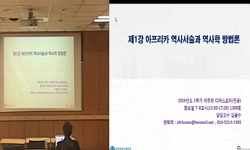◆Recent discussions of interstices between races, ethnicities, nations, states, and cultures produce a delicate and complex concept of hybridity within the context of globalization and transnationalism. Critics and theorists such as Homi Bhabha, Eti...
http://chineseinput.net/에서 pinyin(병음)방식으로 중국어를 변환할 수 있습니다.
변환된 중국어를 복사하여 사용하시면 됩니다.
- 中文 을 입력하시려면 zhongwen을 입력하시고 space를누르시면됩니다.
- 北京 을 입력하시려면 beijing을 입력하시고 space를 누르시면 됩니다.
초국가주의와 문화번역
한글로보기https://www.riss.kr/link?id=G3734045
- 저자
-
발행기관
-
-
발행연도
2011년
-
작성언어
Korean
-
주제어
초국가주의 ; multiculturalism ; postcolonialism ; diaspora ; double consciousness ; hybridity ; globalization ; minority ; Poetries in English ; rap ; hiphop ; jazz ; cultural translation ; transnationalism ; interstices ; borderland culture areas ; reggae ; 문화번역 ; 다문화주의 ; 탈식민주의 ; 디아스포라 ; 탈민족주의 ; 레게 ; 재즈 ; 힙합 ; 랩 ; 영어권 시 ; 소수민족 ; 전지구화 ; 혼종성 ; 이중의식 ; 경계적 문화지역 ; 틈새
-
자료형태
한국연구재단(NRF)
-
0
상세조회 -
0
다운로드
부가정보
다국어 초록 (Multilingual Abstract)
◆Recent discussions of interstices between races, ethnicities, nations, states, and cultures produce a delicate and complex concept of hybridity within the context of globalization and transnationalism. Critics and theorists such as Homi Bhabha, Etienne Balibar, Jahan Ramazani, James Clifford, Richard Kearney, Walter Benn Michaels, Aihwa Ong, and many others have grappled with the project of transnationalism by unknotting this complicated intermixture of the terms which span from global, diasporic, postnational, postcolonial, hemispheric, and transnational. But this project of "cultural translation" still remains problematic.
◆What is at stake in this new discursive dynamics are diasporic subjects and borderline areas of cultures, both of which derive their origins from migration from the home country and assimilation to the host country. Diasporic subjects such as whites, blacks, Asians, hispanics, and what not, become the minority of the host country when they manage to assimilate to the latter, while maintaining their home country's culture and tradition. In the history of religions and other disciplines, diaspora has been employed as a geographic and sociological category. However, in recent postmodern cultural studies, "diaspora consciousness" moves beyond the essentialist concepts such as ethnicity and race, and comes to denote hybridity, heterogeneity, identity fragmentation, double consciousness, roots and routes, and multi-locationality. This disapora consciousness is a product of cultures and histories in collision and dialogue, and diasporic subjects are distinct versions of modern, transnational, and intercultural experience.
◆In this context of diasporic identities and hybridity, multiculturalism has attempted to explain the new forms and complex discursive practices in the contemporary global village. Amy Gutman, David Theo Goldberg, Will Kymlicka, Bhikhu Parekh, and Stephen Castlesbelong to such attempts. They provide a critique of the mono-cultural mono-national myth of a nation-state and envision a multicultural community in which the rights for cultural preservation and community construction are prerequisite, thereby proposing multiculturalism as the revisionist alternative for assimilation policies of immigration of the nationalistic origin. However, the logic of multiculturalism is not sufficient to provide a global phenomenon of the diasporic identities and hybridity.
My argument is that networks of transnationalism can provide a clue to unknot the complicated intermixture of terms which span from diaspora, postcolonialism, and postnationalism. I will investigate the nature of the concepts of diaspora, colonialism, and nationalism from the contradictory counter-concepts of diasporic double consciousness, postcolonialism, and postnationalism, in attempts to retrieve the embedded signifying chains of transnational cultural logic.
◆My attempt is to superimpose a discursive anchor of the concept of the cultural translation on the contemporary critical geographical mappings in the areas of Asia, North America, Carrebean islands, South America, and Europe, thereby constructing a scaffolding of contact zone or tangential point of interstitiality of the triadic borromean knots of national, postnational, and transnational. In short, The cultural logic of transnationalism can be demonstrated in connection with cultural hybridity, diasporic consciousness, and cross-national commodification, and flexible citizenship. For this attempt, the group members of the transnatuonalism and cultural translation project team will pariticipate (giving papers, discussing the relevant topics, and collecting data and writing/pulbishing about the topic under consideration) variuous international conferences, including MLA, ACLA, IASIL, ELLAK, and what not, in order to encounter the the real events of the transnational cultural translation.
국문 초록 (Abstract)
◆소수민족의 문화를 구성하는 백인, 흑인, 아시아인, 히스패닉, 중동인 등 모두가 디아스포라의 이주적 주체를 구성하고 있고, 고향인 모국/조국을 떠나 목적지인 거주국으로 이주하여 새...
◆소수민족의 문화를 구성하는 백인, 흑인, 아시아인, 히스패닉, 중동인 등 모두가 디아스포라의 이주적 주체를 구성하고 있고, 고향인 모국/조국을 떠나 목적지인 거주국으로 이주하여 새로운 국가와 문화에 동화되면서도 갈등을 겪고 있다. 이러한 현상에 대해 다문화주의 시각으로 이미 서구에서는 방대한 선행연구가 이루어져 있다. 다문화주의의 동화주의에 대한 비판은 사회적인 결집성, 문화적 소속감과 동질성, 그리고 정치적 참여를 중심으로 국가의 지리적 행정적 경계 내에서 이민자 영입에서의 동화주의적 모델에 대한 대안을 제시하는 담론이었다. 이러한 담론이 인종, 민족, 국가의 개별적인 개념이 상호간의 개념의 경계를 넘어서는 미묘하고도 복합적인 혼종성의 개념으로 치환되고, 인터넷, 다국적 기업, 모바일 폰과 통신기기 공학의 발달로 인한 세계의 전지구화와 더불어, 디아스포라적 정체성과 혼종성의 문화는 기존의 다문화주의로만으로는 설명할 수 없는 새로운 유형과 복합적인 담론의 내용을 분출해왔다. 이러한 문화이론의 복합성은 때로는 탈식민주의, 때로는 디아스포라 담론, 때로는 탈민족주의 등의 개념으로 설명되어 왔으나 그 실체에 대해서는 여전히 오리무중이다.
◆국내에서는 초국가주의에 대해 연구가 시작된 최근 2005년 이후에, 초국가주의에 대해서 직접 다루거나, 초국가적인 문맥에서 여러 분야를 바라보는 논문은 불과 십 여편도 되지 않는다. 그러나 이들이 다룬 초국가주의는 대부분 단편적이거나 이론적 점검이 불충분하다. 서구에서는 90년대부터 다문화주의에 대한 대안으로서 이미 초국가주의에 대한 논의가 진행되어 왔었다. 베르토벡, 포르테스, 아르준 아파듀라이, 아이와 옹, 에티엔느 발리바, 자한 라마자니, 제임스 클리포드, 리차드 키어니, 월터 벤 마이클스, 등은 초국가주의에 대해, 전 세계가 탈영토화, 디아스포라, 초국가화되고 있다고 주장하고, 글로벌, 민족적, 지역적인 요인을 상호연결시킬 수 있는 틀을 제시하고자 제시해왔다. 대부분의 학자들이 특히 탈민족주의에서의 지역성의 이론적인 도구를 탈민족적인 디아스포라와 초국가적인 문화주의에 초점을 맞추어 논의하고자 하였으나, 오히려 더 복잡한 개념으로 치환되고 있다. 단순히 디아스포라를 탈민족적이라고 할 수 없으며, 문화적 현상의 이동을 초국가적인 특징이라고 할 수 없기 때문이다.
◆ 본 연구는 소수민족이 구성하고 있는 정체성과 문화의 현상을 규명하기 위하여, 먼저 다문화주의에 대한 문헌연구를 통해 문화연구의 기반을 점검한다. 다문화주의의 대안으로 제시되는 초국가주의의 시각을 설정하기 위해 탈식민주의(postcolonialsim), 디아스포라(diaspora), 탈민족주의(postnationalism)의 독립적인 개별적인 개념을 문헌연구를 통해 깊이 있게 천착하여 각각의 잠재적 상호역동성을 도출한다. 탈식민주의의 제 3세계, 디아스포라 이민사회, 그리고 탈민족주의의 인종적 정체성 등의 세 개념의 "의미의 연쇄고리"(signifying)를 보로미안 고리(borromean knots)를 엮듯이, 다문화주의에 새로운 시각을 던져주는 초국가주의의 개념을 설정한다.
◆따라서 본 연구는 초국가주의 공동체의 네트워크의 실체를 알아보고, 탈식민주의와 디아스포라의 이중의식과 연관된 타자화 과정, 탈민족주의와 초국가주의의 탈영토화 과정이 어떻게 진행되는가를 보여주기 위해, 전세계에 편재해











